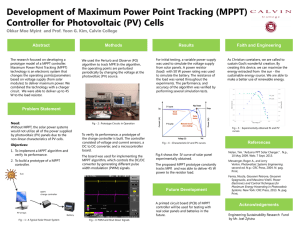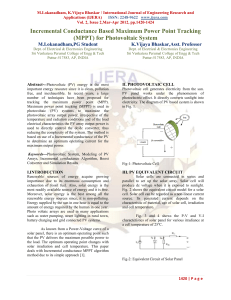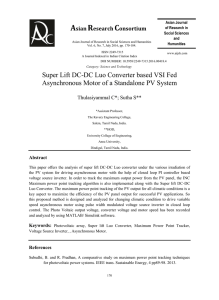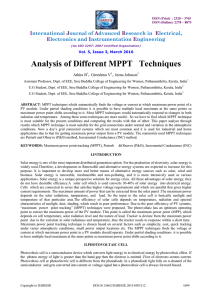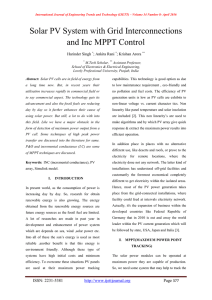MPPT Algorithm for Solar Photovotaic Cell by Incremental
advertisement
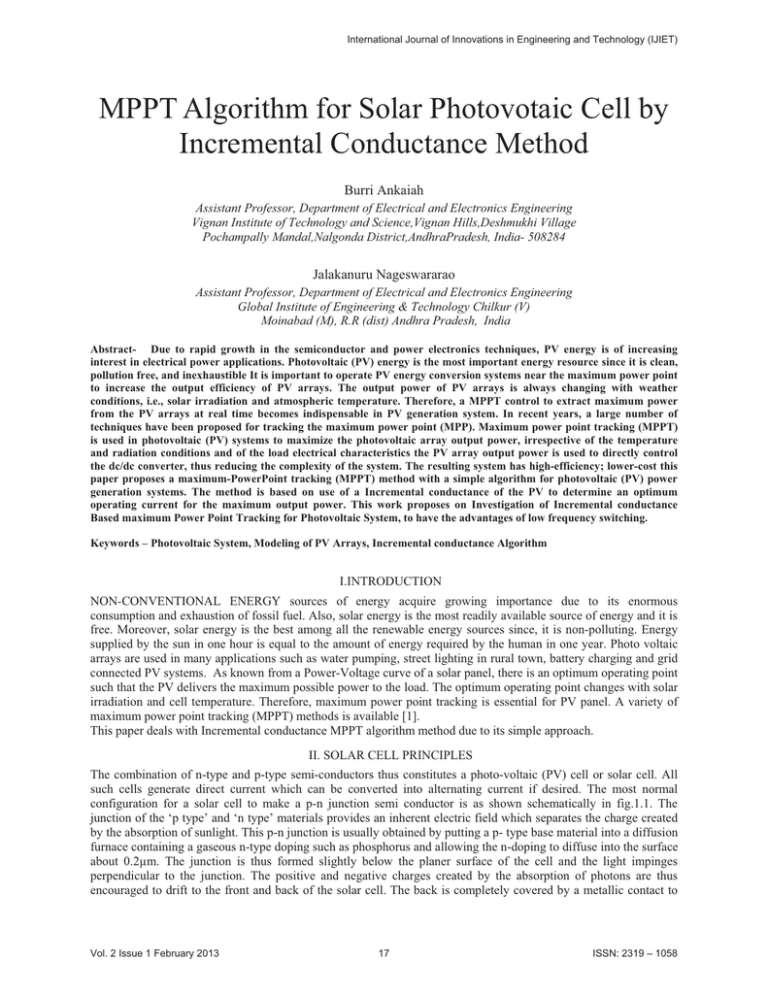
International Journal of Innovations in Engineering and Technology (IJIET) MPPT Algorithm for Solar Photovotaic Cell by Incremental Conductance Method Burri Ankaiah Assistant Professor, Department of Electrical and Electronics Engineering Vignan Institute of Technology and Science,Vignan Hills,Deshmukhi Village Pochampally Mandal,Nalgonda District,AndhraPradesh, India- 508284 Jalakanuru Nageswararao Assistant Professor, Department of Electrical and Electronics Engineering Global Institute of Engineering & Technology Chilkur (V) Moinabad (M), R.R (dist) Andhra Pradesh, India Abstract- Due to rapid growth in the semiconductor and power electronics techniques, PV energy is of increasing interest in electrical power applications. Photovoltaic (PV) energy is the most important energy resource since it is clean, pollution free, and inexhaustible It is important to operate PV energy conversion systems near the maximum power point to increase the output efficiency of PV arrays. The output power of PV arrays is always changing with weather conditions, i.e., solar irradiation and atmospheric temperature. Therefore, a MPPT control to extract maximum power from the PV arrays at real time becomes indispensable in PV generation system. In recent years, a large number of techniques have been proposed for tracking the maximum power point (MPP). Maximum power point tracking (MPPT) is used in photovoltaic (PV) systems to maximize the photovoltaic array output power, irrespective of the temperature and radiation conditions and of the load electrical characteristics the PV array output power is used to directly control the dc/dc converter, thus reducing the complexity of the system. The resulting system has high-efficiency; lower-cost this paper proposes a maximum-PowerPoint tracking (MPPT) method with a simple algorithm for photovoltaic (PV) power generation systems. The method is based on use of a Incremental conductance of the PV to determine an optimum operating current for the maximum output power. This work proposes on Investigation of Incremental conductance Based maximum Power Point Tracking for Photovoltaic System, to have the advantages of low frequency switching. Keywords – Photovoltaic System, Modeling of PV Arrays, Incremental conductance Algorithm I.INTRODUCTION NON-CONVENTIONAL ENERGY sources of energy acquire growing importance due to its enormous consumption and exhaustion of fossil fuel. Also, solar energy is the most readily available source of energy and it is free. Moreover, solar energy is the best among all the renewable energy sources since, it is non-polluting. Energy supplied by the sun in one hour is equal to the amount of energy required by the human in one year. Photo voltaic arrays are used in many applications such as water pumping, street lighting in rural town, battery charging and grid connected PV systems. As known from a Power-Voltage curve of a solar panel, there is an optimum operating point such that the PV delivers the maximum possible power to the load. The optimum operating point changes with solar irradiation and cell temperature. Therefore, maximum power point tracking is essential for PV panel. A variety of maximum power point tracking (MPPT) methods is available [1]. This paper deals with Incremental conductance MPPT algorithm method due to its simple approach. II. SOLAR CELL PRINCIPLES The combination of n-type and p-type semi-conductors thus constitutes a photo-voltaic (PV) cell or solar cell. All such cells generate direct current which can be converted into alternating current if desired. The most normal configuration for a solar cell to make a p-n junction semi conductor is as shown schematically in fig.1.1. The junction of the ‘p type’ and ‘n type’ materials provides an inherent electric field which separates the charge created by the absorption of sunlight. This p-n junction is usually obtained by putting a p- type base material into a diffusion furnace containing a gaseous n-type doping such as phosphorus and allowing the n-doping to diffuse into the surface about 0.2μm. The junction is thus formed slightly below the planer surface of the cell and the light impinges perpendicular to the junction. The positive and negative charges created by the absorption of photons are thus encouraged to drift to the front and back of the solar cell. The back is completely covered by a metallic contact to Vol. 2 Issue 1 February 2013 17 ISSN: 2319 – 1058 International Journal of Innovations in Engineering and Technology (IJIET) remove the charges to the electric load. The collection of charges from the front of the cell is aided by a fine grid of narrow metallic fingers. The surface coverage of the conducting collectors is typically about 5% in order to allow as much light as possible to reach active junction area. An antireflective coating is applied on the top of the cell. The pn junction provides an electrical field that sweeps the electrons in one direction and the positive holes in the other. If the junction is in thermodynamic equilibrium, then the Fermi energy must be uniform throughout. Since the Fermi level is near the top of the gap of an n-doped material and near the bottom of the p-doped Fig. 1.Circuit Diagram of The PV Cell III. BASIC PHOTOVOLTAIC SYSTEM FOR POWER GENERATION A Basic Photovoltaic System integrated with the utility grid is shown in fig.1.4. It permits solar generated electrical power to be delivered to a local load. It consists of solar array, large or small, which converts the insulation to useful DC electrical power. A Blocking Diode which lets the array – generated power flow only toward the battery or grid. Without a blocking diode the battery would discharge back through the solar array during times of no insulation.Fig. 3 and 4 shows the P-V and V-I characteristics of solar panel for various irradiance at a cell temperature of 25C.Battery Storage, in which the solar generated electric energy may be stored.Inverter/Converter, usually solid state which converts the battery bus voltage to AC of frequency and phase to match that needed to integrate with the utility grid. Thus it is typically a DC, Ac inverter. It may also contain a suitable output step up transformer, perhaps some filtering and power factor correction circuits and perhaps some power conditioning, i.e. circuitry to initiate battery charging and to prevent over charging. Power conditioning may be shown as a separate system functional block. This block may also be used in figure shown to function as a rectifier to charge the battery from the utility feeder when needed and when no insulation was present Appropriate Switches and Circuit breakers, to permit isolating parts of the system, as the battery. One would also want to include breakers and fusing protection between the inverter output and the utility grid to protect both the photo voltaic system and the grid Fig-2: Basic photovoltaic system integrated with power grid Fig-3: P-V Characteristics of Solar Panel for Various Irradiance S at a Temperature of 250c Vol. 2 Issue 1 February 2013 18 ISSN: 2319 – 1058 International Journal of Innovations in Engineering and Technology (IJIET) Fig-4: I-V Characteristics of Solar Panel for Various Irradiance S at a Temperature of 250c IV. SYSTEM CONFIGURATION The circuit diagram of Photovoltaic system [7],[8] is shown in Fig 5. The system configuration for the topic is as shown. Here the PV array is a combination of series and parallel solar cells. This array develops the power from the solar energy directly and it will be changes by depending up on the temperature and solar irradiances. So we are controlling this to maintain maximum power at output side we are boosting the voltage by controlling the current of array with the use of PI controller. The relevant circuit is as shown. After we are getting the maximum power we are applying to the utility grid. Fig-5: System Configuration of PV System V.INCREMENTAL CONDUCTANCE MPPT In incremental conductance method the array terminal voltage is always adjusted according to the MPP voltage it is based on the incremental and instantaneous conductance of the PV module Fig-6:Basic idea of incremental conductance method on a P-V Curve of solar module Fig-6 shows that the slope of the P-V array power curve is zero at The MPP, increasing on the left of the MPP and decreasing on the Right hand side of the MPP. The basic equations of this method are as follows. Vol. 2 Issue 1 February 2013 At MPP (1) Left of MPP (2) Right of MPP (3) 19 ISSN: 2319 – 1058 International Journal of Innovations in Engineering and Technology (IJIET) Where I and V are P-V array output current and voltage respectively. The left hand side of equations represents incremental conductance of P-V module and the right hand side represents the instantaneous conductance. When the ratio of change in output conductance is equal to the negative output conductance, the solar array will operate at the maximum power point VI. INCRIMENTAL CONDUCTANCE MPPT ALGORITHM This method exploits the assumption of the ratio of change in output conductance is equal to the negative output Conductance Instantaneous conductance. We have P=VI (4) Applying the chain rule for the derivative of products yields to P/V = [(VI)]/ V (5) At MPP, as P/V=0 (6) The above equation could be written in terms of array voltage V and array current I as I/V = - I/V (7) The MPPT regulates the PWM control signal of the dc – to – dc boost converter until the condition: (I/V) + (I/V) = 0 (8) is satisfied. In this method the peak power of the module lies at above 98% of its incremental conductance. The Flow chart of incremental conductance MPPT is shown below. Fig-7:Incremental conductance MPPT Flow chart Table -1 Advantages and Disadvantages of Incremental conductance MPPT method specification incremental conductance efficiency high about 98% complexity difficulty realization more complex cost high cost reliability accurate rapidly changing atmosphere good and automatically adjusts modules operating voltage Vol. 2 Issue 1 February 2013 20 ISSN: 2319 – 1058 International Journal of Innovations in Engineering and Technology (IJIET) VII.SIMULATION CIRCUIT Fig-8: Simulation circuit of the Incremental Conductance Method VIII.SIMULATION RESULTS Let us consider photovoltaic cell with Irradiance is 1000w/m2 And Temperature is 25oc and Simulated the Circuit without maximum power point tracking controller and with maximum power point tracking and the results are show in the below . Fig-9:PV Output Voltage Without MPPT Controller Fig-10: PV Output Voltage With MPPT Controller Fig-11: PV-Output Current Without MPPT Controller Vol. 2 Issue 1 February 2013 21 ISSN: 2319 – 1058 International Journal of Innovations in Engineering and Technology (IJIET) Fig-12: PV-Output Current With MPPT Controller Fig-13: PV-Output Power Without MPPT Controller Fig-14 PV- Output Power With MPPT Controller Fig-15: PV-Output Power of with and without MPPT IX.CONCLUSION The paper proposes a simple MPPT method that requires only measurements of Incremental conductance. The proposed MPPT algorithm is called Incremental conductance Method. However, by using this MPPT method we have increased efficiency by 44%. This method compute the maximum power and controls directly the extracted power from the PV.The proposed method offers different advantages which are: good tracking efficiency, response is high and well control for the extracted power. X.ACKNOWLEDGMENT I offer my sincere thanks to God and my family for giving me an opportunity to dedicate my time and energy.. The first author is thankful to C.HARINATHA REDDY Head of Electrical and Electronics Engineering Department, for his constant support and guidance. Special thanks to Vignan Institute of Technology and Science, for encouraging. Vol. 2 Issue 1 February 2013 22 ISSN: 2319 – 1058 International Journal of Innovations in Engineering and Technology (IJIET) REFERENCES [1] Hussein, K.H., Murta,I., Hoshino,T., Osakada,M.,“Maximum photovoltaic power tracking: an algorithm for rapidly changing atmospheric conditions”, IEEE Proceedings of Generation, [2] E. Koutroulis, et. Al, “Development of a Microcontroller-based photovoltaic maximum power tracking control system”, IEEE Trans. On power Electron, VOl.16, No. 1, PP.46-54, 2001, [3] A.Jiang et. Al.,”Maximum Power Tracking for Photovoltaic Power Systems,” Tamkang Journal of Science and Engineering, Vol. 8, No. 2, pp. 147-153, 2005. [4] S. Jain and V. Agarwal, “A New Algorithm for Rapid Tracking of Approximate Maximum Power Point in Photovoltaic Systems”’ IEEE Power Electronic Letter, Vol.2, pp. 16-19, Mar.2004. [5] Y.Kuo, et. Al., “Maximum power point tracking controller for photovoltaic energy conversion system”, IEEE Trans. Ind. Electron. Vol.48, pp. 594-601, 2001. [6] Rafia Akhter and Aminul Hoque, “Analysis of a PWM Boost Inverter for Solar Home Application”, Proceedings of World academy Of Science, Engineering And Technology Volume 17 December 2006 ISSN 1307-6884. [7] Huan-Liang Tsai, Ci-Siang Tu and Yi-Jie Su, “Development of Generalized Photovoltaic Modeling Using MATLAB/Simulink, Proceedings of the World Congress on Engineering and Computer Science 2008 WCECS 2008, October 22-24, 2008, San Francisco, USA [8] Francisco M. Gonzalez-Longatt, “Model of Photovoltaic Module in matlabtm”, 2do congreso ibero americano de ESTUDIANTES DE INGENIERIA ELECTRICA, ELECTRONICA Y COMPUTACION(II CIBELEC 2005). [9] Yang Chen and Keyue Ma Smedley,”Cost-Effective Single-Stage Inverter With Maximum Power Point Tracking, IEEE TRANSACTIONS ON POWER ELECTRONICS, VOL. 19, NO:5, SEPTEMBER 2004. [10] I.H. Altas and A.M. Sharaf, “A Novel On-Line MPP Search Algorithm For PV Arrays”, IEEE Transactions on Energy Conversion, Vol. 11, No. 4, December 1996. [11] S. Balakrishna, V. Gajendra, M. Mohan, M. Suresh,“Design Aspects Of Microcontroller Based Maximum Power Point Tracking Controller For PV System”, Proceedings of 2nd International Conference on Mechatronics 2005, Vol.1, pp 263– 269, Malaysia, 2005 Vol. 2 Issue 1 February 2013 23 ISSN: 2319 – 1058
